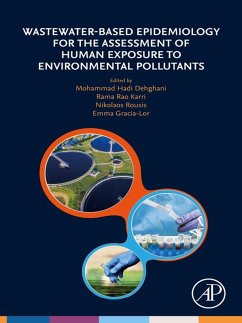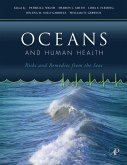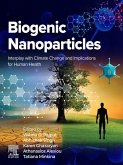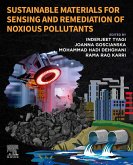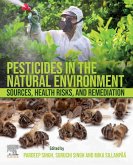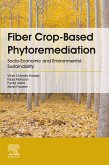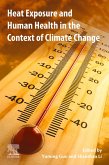Wastewater-Based Epidemiology for the Assessment of Human Exposure to Environmental Pollutants (eBook, ePUB)
Redaktion: Hadi Dehghani, Mohammad; Gracia-Lor, Emma; Rousis, Nikolaos; Karri, Rama Rao


Alle Infos zum eBook verschenken

Wastewater-Based Epidemiology for the Assessment of Human Exposure to Environmental Pollutants (eBook, ePUB)
Redaktion: Hadi Dehghani, Mohammad; Gracia-Lor, Emma; Rousis, Nikolaos; Karri, Rama Rao
- Format: ePub
- Merkliste
- Auf die Merkliste
- Bewerten Bewerten
- Teilen
- Produkt teilen
- Produkterinnerung
- Produkterinnerung

Hier können Sie sich einloggen

Bitte loggen Sie sich zunächst in Ihr Kundenkonto ein oder registrieren Sie sich bei bücher.de, um das eBook-Abo tolino select nutzen zu können.
Wastewater-based Epidemiology for the Assessment of Human Exposure to Environmental Pollutants discusses wastewater-based epidemiology (WBE) and its use in risk assessment and monitoring of human exposure to hazardous pollutants and pathogens. The book explores the health impacts of organic and inorganic pollutants from pesticides, heavy metals, pharmaceuticals, phthalates, personal care products, and endocrine disruptors in the wastewater environment. The book examines the application of wastewater-based epidemiology in determining health risk and exposure to infectious diseases caused by…mehr
- Geräte: eReader
- ohne Kopierschutz
- eBook Hilfe
- Größe: 13.36MB
![Oceans and Human Health (eBook, ePUB) Oceans and Human Health (eBook, ePUB)]() Oceans and Human Health (eBook, ePUB)127,95 €
Oceans and Human Health (eBook, ePUB)127,95 €![Biogenic Nanoparticles (eBook, ePUB) Biogenic Nanoparticles (eBook, ePUB)]() Biogenic Nanoparticles (eBook, ePUB)102,95 €
Biogenic Nanoparticles (eBook, ePUB)102,95 €![Sustainable Materials for Sensing and Remediation of Noxious Pollutants (eBook, ePUB) Sustainable Materials for Sensing and Remediation of Noxious Pollutants (eBook, ePUB)]() Sustainable Materials for Sensing and Remediation of Noxious Pollutants (eBook, ePUB)89,95 €
Sustainable Materials for Sensing and Remediation of Noxious Pollutants (eBook, ePUB)89,95 €![The Quality of Air (eBook, ePUB) The Quality of Air (eBook, ePUB)]() The Quality of Air (eBook, ePUB)135,95 €
The Quality of Air (eBook, ePUB)135,95 €![Pesticides in the Natural Environment (eBook, ePUB) Pesticides in the Natural Environment (eBook, ePUB)]() Pesticides in the Natural Environment (eBook, ePUB)102,95 €
Pesticides in the Natural Environment (eBook, ePUB)102,95 €![Fiber Crop-Based Phytoremediation (eBook, ePUB) Fiber Crop-Based Phytoremediation (eBook, ePUB)]() Pooja MahajanFiber Crop-Based Phytoremediation (eBook, ePUB)102,95 €
Pooja MahajanFiber Crop-Based Phytoremediation (eBook, ePUB)102,95 €![Heat Exposure and Human Health in the Context of Climate Change (eBook, ePUB) Heat Exposure and Human Health in the Context of Climate Change (eBook, ePUB)]() Yuming GuoHeat Exposure and Human Health in the Context of Climate Change (eBook, ePUB)102,95 €
Yuming GuoHeat Exposure and Human Health in the Context of Climate Change (eBook, ePUB)102,95 €-
-
-
Dieser Download kann aus rechtlichen Gründen nur mit Rechnungsadresse in A, B, BG, CY, CZ, D, DK, EW, E, FIN, F, GR, HR, H, IRL, I, LT, L, LR, M, NL, PL, P, R, S, SLO, SK ausgeliefert werden.
- Produktdetails
- Verlag: Elsevier Science & Techn.
- Seitenzahl: 264
- Erscheinungstermin: 30. Juli 2023
- Englisch
- ISBN-13: 9780443161469
- Artikelnr.: 68519463
- Verlag: Elsevier Science & Techn.
- Seitenzahl: 264
- Erscheinungstermin: 30. Juli 2023
- Englisch
- ISBN-13: 9780443161469
- Artikelnr.: 68519463
- Herstellerkennzeichnung Die Herstellerinformationen sind derzeit nicht verfügbar.
About the editors
Preface
Acknowledgments
1. Wastewater-based epidemiology: Evidence mapping toward identifying
emerging areas of research
Mina Aghaei, Masud Yunesian, Hosna Janjani and Mohammad Hadi Dehghani
1.1 Introduction
1.2 Material and methods
1.3 Results and discussion
1.4 Challenges and limitations
1.5 Conclusion
Conflict of interest
Acknowledgment
References
2. Moving beyond wastewater analysis toward epidemiology
Cobus Gerber, Emma L. Jaunay, Bradley S. Simpson and Jason M. White
2.1 Introduction
2.2 Drug consumption, metabolism, and excretion
2.3 Wastewater sampling and analysis
2.4 Beyond analysis toward epidemiology
2.5 Conclusions
References
3. Sampling techniques in wastewater-based epidemiology approach
Lilian Feltraco Lizot, Marcos Frank Bastiani, Camila Favretto de Souza,
Roberta Zilles Hahn and Rafael Linden
3.1 Introduction
3.2 Active sampling
3.3 Passive sampling
3.4 Conclusion
References
4. Assessment of in-sample and in-sewer stability of biomarkers in
wastewater-based epidemiology: an important step
Jianfa Gao, Jake W. O'Brien, Jiaying Li, Phil Choi, Yijing Li and Phong K.
Thai
4.1 Introduction
4.2 Methodology used to evaluate biomarker stability
4.3 In-sewer stabilities of biomarkers
4.4 In-sample stability of biomarkers and the selection of preservative
methods
4.5 Factors affecting the degradation of biomarkers
4.6 Implications for wastewater-based epidemiology
4.7 Conclusions
Acknowledgement
References
5. Population biomarkers for wastewater-based epidemiology
Jake W. O'Brien, Phong K. Thai and Benjamin J. Tscharke
5.1 Introduction
5.2 Flowdthe first proposed wastewater population biomarker
5.3 What makes a good wastewater-based epidemiology population marker?
5.4 Summary and perspective: continuing the quest for identifying
population biomarkers
Acknowledgements
References
6. Wastewater-based epidemiology through pharmaceuticals as biochemical
markers and associated challenges
Charu Juneja, Purusottam Tripathy, Om Prakash, Deepak Panchal, Abhishek
Sharma, Ritesh Vijay and Sukdeb Pal
6.1 Introduction
6.2 Water fingerprinting through WBE: a new approach to evaluating public
health
6.3 Biomarkers of pharmaceuticals and personal care products
6.4 Population biomarker: a paradigm for PPCPs prevalence
6.5 Limitations
6.6 Conclusion
Acknowledgments
References
7. The complexities associated with the detection of new psychoactive
substances in wastewater
Richard Bade, Dhayaalini Nadarajan and Cobus Gerber
7.1 Introduction
7.2 Analytical methods
7.3 Considerations for future methods
7.4 Conclusion
References
8. Wastewater-based epidemiology for assessing and monitoring human
exposure to pesticides
Evsen Yavuz Guzel, Asli Atasoy Aydin and Nebile Daglioglu
8.1 Introduction
8.2 Pesticides groups
8.3 Analytical method
8.4 Stability of parent pesticides and their metabolites in wastewater
8.5 Human risk assessment
8.6 Limitations and future research needs
8.7 Conclusion
References
9. Expansion and diversification of wastewater-based epidemiology
strategies in pandemic conditions to serve immediate public health goals
Erin M. Driver, Devin A. Bowes and Rolf U. Halden
9.1 Introduction
9.2 Materials and methods
9.3 Results and discussion
9.4 Conclusion
References
10. Viral surveillance of wastewater as a promising tool to assess the
spread of pathogens in the population: the experience of SARS-CoV-2
Giulia Salmoiraghi, Silvia Schiarea, Laura Pellegrinelli, Valeria Primache,
Sandro Binda, Elena Pariani, Giovanni Nattino, Guido Bertolini, Francesca
Pizza, Ettore Zuccato and Sara Castiglioni
10.1 Introduction
10.2 Aim of the study
10.3 Material and methods
10.4 Results and discussion
10.5 Conclusion
Acknowledgments
References
Index
About the editors
Preface
Acknowledgments
1. Wastewater-based epidemiology: Evidence mapping toward identifying
emerging areas of research
Mina Aghaei, Masud Yunesian, Hosna Janjani and Mohammad Hadi Dehghani
1.1 Introduction
1.2 Material and methods
1.3 Results and discussion
1.4 Challenges and limitations
1.5 Conclusion
Conflict of interest
Acknowledgment
References
2. Moving beyond wastewater analysis toward epidemiology
Cobus Gerber, Emma L. Jaunay, Bradley S. Simpson and Jason M. White
2.1 Introduction
2.2 Drug consumption, metabolism, and excretion
2.3 Wastewater sampling and analysis
2.4 Beyond analysis toward epidemiology
2.5 Conclusions
References
3. Sampling techniques in wastewater-based epidemiology approach
Lilian Feltraco Lizot, Marcos Frank Bastiani, Camila Favretto de Souza,
Roberta Zilles Hahn and Rafael Linden
3.1 Introduction
3.2 Active sampling
3.3 Passive sampling
3.4 Conclusion
References
4. Assessment of in-sample and in-sewer stability of biomarkers in
wastewater-based epidemiology: an important step
Jianfa Gao, Jake W. O'Brien, Jiaying Li, Phil Choi, Yijing Li and Phong K.
Thai
4.1 Introduction
4.2 Methodology used to evaluate biomarker stability
4.3 In-sewer stabilities of biomarkers
4.4 In-sample stability of biomarkers and the selection of preservative
methods
4.5 Factors affecting the degradation of biomarkers
4.6 Implications for wastewater-based epidemiology
4.7 Conclusions
Acknowledgement
References
5. Population biomarkers for wastewater-based epidemiology
Jake W. O'Brien, Phong K. Thai and Benjamin J. Tscharke
5.1 Introduction
5.2 Flowdthe first proposed wastewater population biomarker
5.3 What makes a good wastewater-based epidemiology population marker?
5.4 Summary and perspective: continuing the quest for identifying
population biomarkers
Acknowledgements
References
6. Wastewater-based epidemiology through pharmaceuticals as biochemical
markers and associated challenges
Charu Juneja, Purusottam Tripathy, Om Prakash, Deepak Panchal, Abhishek
Sharma, Ritesh Vijay and Sukdeb Pal
6.1 Introduction
6.2 Water fingerprinting through WBE: a new approach to evaluating public
health
6.3 Biomarkers of pharmaceuticals and personal care products
6.4 Population biomarker: a paradigm for PPCPs prevalence
6.5 Limitations
6.6 Conclusion
Acknowledgments
References
7. The complexities associated with the detection of new psychoactive
substances in wastewater
Richard Bade, Dhayaalini Nadarajan and Cobus Gerber
7.1 Introduction
7.2 Analytical methods
7.3 Considerations for future methods
7.4 Conclusion
References
8. Wastewater-based epidemiology for assessing and monitoring human
exposure to pesticides
Evsen Yavuz Guzel, Asli Atasoy Aydin and Nebile Daglioglu
8.1 Introduction
8.2 Pesticides groups
8.3 Analytical method
8.4 Stability of parent pesticides and their metabolites in wastewater
8.5 Human risk assessment
8.6 Limitations and future research needs
8.7 Conclusion
References
9. Expansion and diversification of wastewater-based epidemiology
strategies in pandemic conditions to serve immediate public health goals
Erin M. Driver, Devin A. Bowes and Rolf U. Halden
9.1 Introduction
9.2 Materials and methods
9.3 Results and discussion
9.4 Conclusion
References
10. Viral surveillance of wastewater as a promising tool to assess the
spread of pathogens in the population: the experience of SARS-CoV-2
Giulia Salmoiraghi, Silvia Schiarea, Laura Pellegrinelli, Valeria Primache,
Sandro Binda, Elena Pariani, Giovanni Nattino, Guido Bertolini, Francesca
Pizza, Ettore Zuccato and Sara Castiglioni
10.1 Introduction
10.2 Aim of the study
10.3 Material and methods
10.4 Results and discussion
10.5 Conclusion
Acknowledgments
References
Index
